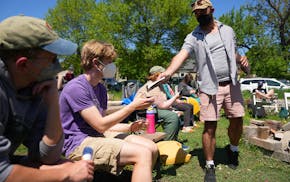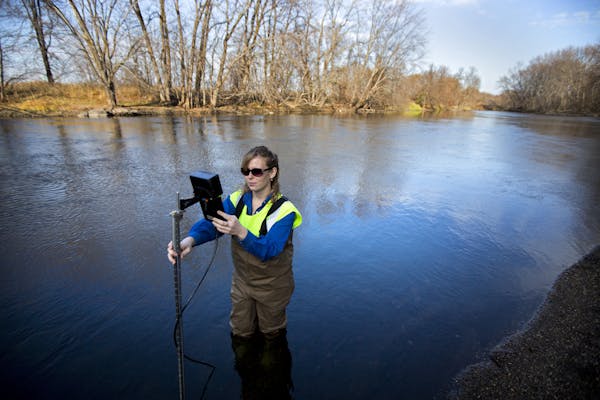The people of Hendricks, Minn., thought they had won the feedlot war two years ago when they sued to stop a mega-dairy slated for a hilltop just across the border in South Dakota.
They feared that if the farm's huge manure lagoons ever sprang a leak, the waste would enter a nearby stream and run straight down into Lake Hendricks, a civic gem they just rescued from years of pollution.
But now, for a second time, county officials in South Dakota granted a permit for the 4,000-cow feedlot. And opponents find themselves up against not just the leaders of Brookings County and a big dairy business operator, but also the state's governor — an enterprising Republican who is courting dairy farmers from California and elsewhere with the promise of plentiful water, low taxes and light regulation.
Shocked by their loss, members of the Lake Hendricks Improvement Association are contemplating their next step. On Dec. 13, they met and discussed how to fight on, then tabled the decision for another two weeks, buying time to find a second round of funding. The first lawsuit cost $90,000, members said, and they are tapped out.
"We're essentially back to square one," said former mayor Jay Nelson.
The fight highlights the fundamental challenges of how environmental resources are managed when shared across state borders. Brookings County has become South Dakota's largest milk-producing county with eight big dairy feedlots. Officials there say they can protect local water without shutting down an important economic engine.
Opponents in Hendricks, home to about 1,100 people if you count the lake homes, cite calculations by the U.S. Environmental Protection Agency that a farm with 4,000 dairy cows would produce the same volume of waste as a city of 650,000 people.
"If there's a major spill, it's a South Dakota problem for one hour and it's a Minnesota problem for a long period of time," said Tom Landmark, the lake association secretary.
And Brookings isn't the only county that drains into Minnesota. Parts of six other South Dakota counties do, too, said Jay Gilbertson, manager of the East Dakota Water Development District.
Consultants have been screening the state for suitable spots for potential concentrated animal feeding operations, or CAFOs — areas that meet all the required setbacks and are near a power line and paved road. Roughly 300 of the potential CAFO sites identified would drain into Minnesota.
Three manure lagoons
For Hendricks residents, what really hurts is that they've fought hard to clean up their town's tadpole-shaped lake, which had been so choked with algae that fishing lures wouldn't sink.
"We haven't had a significant algae bloom in three or four years," Landmark said.
Landmark wasn't familiar with the term NIMBY (not in my back yard). But he called it an apt summary of his association's decades-old mission to protect Lake Hendricks. It's not a negative, he said, not if you're protecting something you care deeply about.
Lake Hendricks straddles both states. Some association board members live on the South Dakota side, others in Minnesota. The group is incorporated in South Dakota and has a Hendricks address.
The states also share watersheds, including one in that part of Brookings County. The three manure lagoons on the proposed mega-dairy would sit about 500 to 600 feet from a stream that flows into nearby Deer Creek, which travels downhill into Lake Hendricks a few miles away.
The lake also is the headwaters of the Lac qui Parle River, which feeds into the Minnesota River and then the Mississippi.
Earlier this year, when their lawsuit still was wending its way through the courts, the Lake Hendricks association retained lawyers to get an audience with Gov. Mark Dayton. They met, and Dayton "was very interested in our case," Landmark said. But they haven't reached out to the governor again since then, he said.
It doesn't appear likely that they'll receive much help from Minnesota regulators.
Randy Hukriede, feedlot program manager for the Minnesota Pollution Control Agency, said the case is on his radar. But he also said South Dakota's feedlot permitting rules are similar to Minnesota's, adding: "We're confident that they have the requirements in place in their permit process to protect the environment."
Irish dairyman, French cheese
The proposed mega-dairy is the latest CAFO proposed for Brookings County, a hotbed for mega-dairies flocking to South Dakota's north-south Interstate 29 corridor. Shiny steel milk tankers zoom up and down the interstate between Brookings and Sioux Falls.
Statewide, the industry has grown from 80,000 cows in 2005 to 115,000 today, according to David Skaggs, a dairy development specialist at the South Dakota Department of Agriculture. That's still modest compared to Minnesota, which has plateaued at about 460,000 cows.
But South Dakota has fully embraced the big-feedlot model: The average dairy farm in Minnesota has 100 cows. The average in South Dakota is 495. Only a few Minnesota dairies are larger than 4,000.
The feedlot in question is being developed by Michael Crinion, an Irishman who relocated to South Dakota and heads Global Dairy LP, which supplies milk to a cheese plant in Brookings. The plant is owned by Bel Brands, a U.S. subsidiary of a large French cheese conglomerate, and churns out colorfully wrapped Mini Babybel cheese wheels.
Crinion's dairy proposal now heads to South Dakota's Department of Environment and Natural Resources for approval.
Brookings County officials said that if Crinion receives final state approval for the project, he plans to turn it over to California dairyman Frank Gwerder. Neither Crinion nor Gwerder responded to calls for this article.
Roger Scheibe, head of the South Dakota Dairy Producers in Brookings, said Gwerder was "committed to relocate" to the Midwest.
"Actually, the last time I talked to them, a week ago," Scheibe said, "they were even looking at Lake Hendricks for a potential home."
Jennifer Bjorhus • 612-673-4683

Want to share info with the Star Tribune? How to do it securely

'Safe recovery sites' would offer syringes, naloxone and more to people using drugs. The plan could be in peril.
New Minnesota GOP leaders seek peace with party's anti-establishment wing

Who is Republican Lisa Demuth, Minnesota's first House speaker of color?

